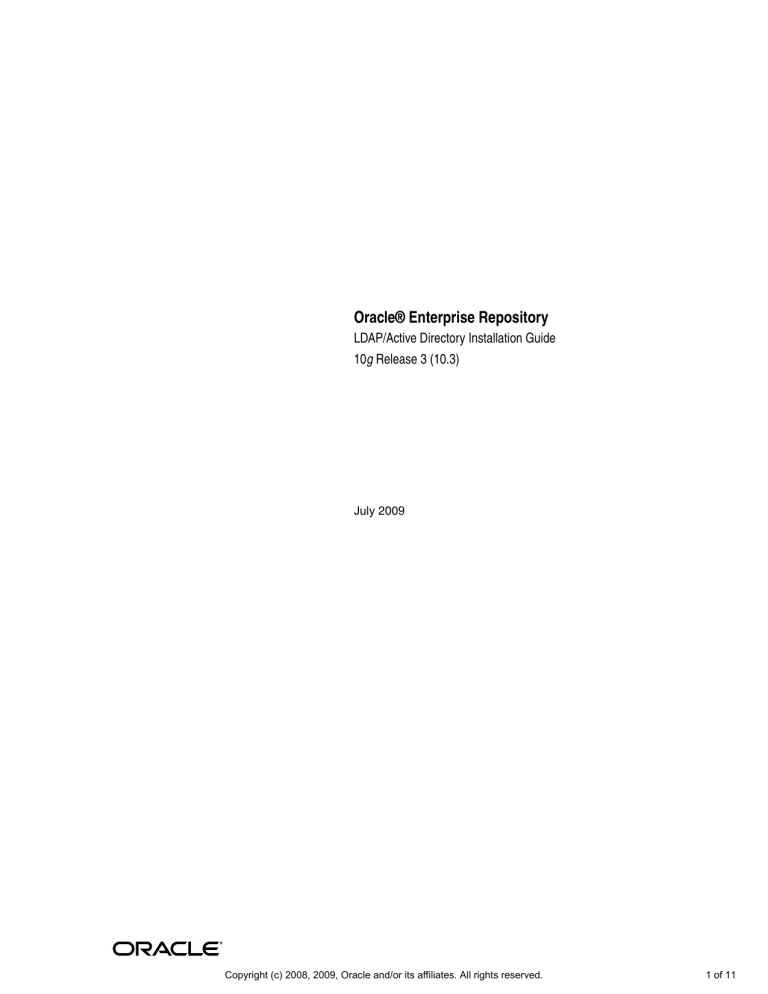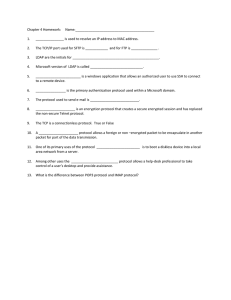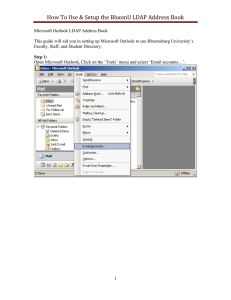
Oracle® Enterprise Repository
LDAP/Active Directory Installation Guide
10g Release 3 (10.3)
July 2009
Copyright (c) 2008, 2009, Oracle and/or its affiliates. All rights reserved.
1 of 11
Oracle Enterprise Repository LDAP/Active Directory Installation Guide, 10g Release 3 (10.3)
Copyright © 2008, 2009, Oracle. All rights reserved.
Primary Author: Vimmika Dinesh
Contributing Author: Scott Spieker, Jeff Schieli, Sharon Fay
The Programs (which include both the software and documentation) contain proprietary information; they
are provided under a license agreement containing restrictions on use and disclosure and are also protected
by copyright, patent, and other intellectual and industrial property laws. Reverse engineering, disassembly,
or decompilation of the Programs, except to the extent required to obtain interoperability with other
independently created software or as specified by law, is prohibited.
The information contained in this document is subject to change without notice. If you find any problems in
the documentation, please report them to us in writing. This document is not warranted to be error-free.
Except as may be expressly permitted in your license agreement for these Programs, no part of these
Programs may be reproduced or transmitted in any form or by any means, electronic or mechanical, for any
purpose.
If the Programs are delivered to the United States Government or anyone licensing or using the Programs on
behalf of the United States Government, the following notice is applicable:
U.S. GOVERNMENT RIGHTS Programs, software, databases, and related documentation and technical data
delivered to U.S. Government customers are "commercial computer software" or "commercial technical data"
pursuant to the applicable Federal Acquisition Regulation and agency-specific supplemental regulations. As
such, use, duplication, disclosure, modification, and adaptation of the Programs, including documentation
and technical data, shall be subject to the licensing restrictions set forth in the applicable Oracle license
agreement, and, to the extent applicable, the additional rights set forth in FAR 52.227-19, Commercial
Computer Software--Restricted Rights (June 1987). Oracle USA, Inc., 500 Oracle Parkway, Redwood City, CA
94065.
The Programs are not intended for use in any nuclear, aviation, mass transit, medical, or other inherently
dangerous applications. It shall be the licensee's responsibility to take all appropriate fail-safe, backup,
redundancy and other measures to ensure the safe use of such applications if the Programs are used for such
purposes, and we disclaim liability for any damages caused by such use of the Programs.
Oracle, JD Edwards, PeopleSoft, and Siebel are registered trademarks of Oracle Corporation and/or its
affiliates. Other names may be trademarks of their respective owners.
The Programs may provide links to Web sites and access to content, products, and services from third
parties. Oracle is not responsible for the availability of, or any content provided on, third-party Web sites.
You bear all risks associated with the use of such content. If you choose to purchase any products or services
from a third party, the relationship is directly between you and the third party. Oracle is not responsible for:
(a) the quality of third-party products or services; or (b) fulfilling any of the terms of the agreement with the
third party, including delivery of products or services and warranty obligations related to purchased
products or services. Oracle is not responsible for any loss or damage of any sort that you may incur from
dealing with any third party.
Copyright (c) 2008, 2009, Oracle and/or its affiliates. All rights reserved.
2 of 11
Oracle Enterprise Repository
LDAP/Active Directory Installation Guide
When utilizing LDAP / Active Directory to authenticate users, some consideration must be
given to the user's department and role configurations prior to the utilization of LDAP /
Active Directory server. All users will be authenticated through LDAP/AD once the
integration is enabled; it is essential to have at least one admin level user account created
within the Oracle Enterprise Repository database that matches the username from LDAP/
AD. This user account should be assigned the admin role so that administrative functions
within Oracle Enterprise Repository can still be performed when LDAP/AD is enabled.
If Role synchronization is enabled from LDAP/AD, at least one user account should be
assigned an administrative-level role. LDAP roles should be created and appropriate OER
permissions assigned within Oracle Enterprise Repository prior to utilizing the role-synch
option. Role names are synchronized on name only. When the administrative level user
logs into Oracle Enterprise Repository using LDAP/AD, that person will have the ability to
configure and administer the application properly. This user account should NOT be used
for daily activities.
Enable LDAP Integration System Properties
This procedure is performed on the Oracle Enterprise Repository Admin screen.
1. Click System Settings in the left pane.
The System Settings section opens in the main pane.
2. Locate the Cookie Login Settings group in the Enterprise Authentication
section.
Copyright (c) 2008, 2009, Oracle and/or its affiliates. All rights reserved.
3 of 11
3. Make sure the Allow Cookie Login setting is set to False
4. Use the System Settings Search box to easily locate each of the following
settings.
5. Enter enterprise.authentication.ldap.enabled into the Search box. Set
the value to True and click Save.
Change the settings as indicated below. Pay particular attention to the True \ False
settings for each.
❍
❍
❍
❍
❍
❍
❍
Default to Cookie Login
■ Set to False.
Unapproved User Login
■ Set to True.
Cookie Login Module
■ Set to False.
Cookie Login Module - Internal Checking
■ Set to False.
Plug-in Login Module Class Name
■ Enter com.flashline.enterprise.authentication.server.
loginmodule.LDAPLogin in the text box.
■ Note: This property turns LDAP on/off. Once enabled, the
application will use LDAP server for user authentication.
Plug-in Login Module Display Name
■ Enter Enterprise LDAP Login in the text box.
Plug-in Login Module
■ Set to True.
Copyright (c) 2008, 2009, Oracle and/or its affiliates. All rights reserved.
4 of 11
❍
Plug-in Login Module - Internal Checking
■ Set to False.
6. Click Save when finished.
Modify LDAP/Active Directory Properties
1. Click System Settings in the left pane.
2. Use the System Settings Search to easily locate each of the following settings.
Enter the values as indicated below.
Pay particular attention to the True \ False setting for each.
❍
❍
❍
❍
❍
❍
LDAP Server Host Name
■ In the text box, enter the Host name, or the directory server IP
address.
LDAP Server Port Number
■ Enter 389 in the text box.
LDAP Mask
■ Enter uid\=^ for LDAP
or...
■ Enter samAccountName\=^ for Active Directory
Creation of Unapproved User Accounts
■ Set to True.
Assign default roles to users
■ Set to True.
■ Note: This property will assign default roles on every user
authentication.
Auto create missing roles
■ Set to True.
■ Note: This property will create roles synchronized from the
LDAP/AD server, but will NOT assign any permissions to those
roles.
Copyright (c) 2008, 2009, Oracle and/or its affiliates. All rights reserved.
5 of 11
❍
❍
❍
❍
❍
❍
❍
❍
Auto create missing departments
■ Set to True.
■ Note: This property will create departments synchronized from
the LDAP/AD server, but will NOT assign any description to
those departments. However, the user WILL be assigned to the
new role.
LDAP Version
■ Enter 3 in the text box. (Supported versions are 2 and 3)
Administrator Account Distinguished Name
■ Note: This property is required with using Active Directory. This
property must contain a DN of a user account with at least read-only
directory look-up permissions.
■ Example: CN=Some_User,CN=Users,DC=ad,DC=example,
DC=com
Administrator Account Password
■ In the text box, enter the password for the administrator account
identified in the Administrator Account Distinguished Name
property, above.
Use SSL Connection
■ Set to True to enable an SSL connection for LDAP. Default is false.
Follow referrals
■ Set to True.
Retrieve data using the admin account
■ Set to False for LDAP (if applicable) Or
■ Set to True for Active Directory or restricted LDAP environments.
Search Start Location
■ Note: This property defines where in the directory tree the search for
user records will begin.
■ Examples:
■ For LDAP:
■ OU=MemberGroupB, O=en_us
■
❍
For Active Directory: CN=Users,DC=ad,DC=example,DC=com
Search Scope
Copyright (c) 2008, 2009, Oracle and/or its affiliates. All rights reserved.
6 of 11
■
❍
Attribute Name that Identifies a Found Entry
■ Note: This property designates the attribute name that uniquely
identifies the user account within the scope of the tree search.
■
■
❍
❍
❍
❍
❍
❍
❍
❍
❍
Select subtree in the drop-down.
■ Note: This property defines the depth (below the baseDN) of
user record searches.
For LDAP: uid Or
For Active Directory: samAccountName
Found Entry Email Attribute Name
■ Enter mail
Found Entry First Name Attribute Name
■ Enter givenName
Found Entry Middle Name Attribute Name
■ Enter the middle name attribute from your LDAP or Active Directory (if
applicable)
Found Entry Last Name Attribute Name
■ Enter sn
Found Entry Telephone Number Attribute Name
■ Enter telephoneNumber
Use LDAP Departments
■ Set to True
■ Note: This property defines the user's department attribute
value that will be synchronized within Oracle Enterprise
Repository.
Department Attribute
■ Enter department
Use LDAP Roles
■ Set to False
Role Attribute
■ Enter the LDAP / Active directory attribute that contains the role
information for the user.
Copyright (c) 2008, 2009, Oracle and/or its affiliates. All rights reserved.
7 of 11
❍
Second Level Lookup Attribute
■ Note: This property defines the attribute that identifies a second-level
lookup to retrieve user info; the value must be a DN. If you are using a
redirect for second level lookups, define the base DN for this second
lookup.
3. Click Save when finished.
4. Restart the Oracle Enterprise Repository application.
Security Considerations
Using the Oracle Enterprise Repository LDAP/Active Directory Connector allows LDAP to
act as the single source of user identification for Oracle Enterprise Repository user
authentication and role assignment. However, this does not prevent respective host
repositories from managing user authentication for access to files via Oracle Enterprise
Repository.
When using the Oracle Enterprise Repository LDAP/Active Directory Connector, Oracle
Enterprise Repository depends on LDAP or Active Directory to authenticate users. The
username/password combination is delegated to the LDAP system as a bind request. The
user is authenticated only if the bind request is successful.
As an option, LDAP can be configured to store/retrieve Oracle Enterprise Repository user
role assignments. In this configuration, at each user login Oracle Enterprise Repository
synchronizes with the user's roles as stored in LDAP. Roles are added directly through
LDAP, and are not managed by Oracle Enterprise Repository.
Use Case Sample Scenarios
The following scenarios illustrate a selection of LDAP setups and configurations in order
to clarify property settings for user management.
Scenario 1
Prevent user access to Oracle Enterprise Repository despite LDAP
authentication. Access is provided only to pre-existing users with active
Copyright (c) 2008, 2009, Oracle and/or its affiliates. All rights reserved.
8 of 11
Oracle Enterprise Repository accounts.
●
Rationale
❍ Non-enterprise license agreements where user base is
predefined and number of users allowed into the application is
limited.
●
Property Settings
❍ ldap.allow-user-creation
■ Set to False
❍ enterprise.security.unapproveduser.allowlogin
■ Set to False
Scenario 2
On LDAP authentication, create a default Oracle Enterprise Repository user
account and assign the default role(s), but deny the user access to the
Oracle Enterprise Repository.
●
Rationale
❍ To deny Oracle Enterprise Repository access to a new user
until the security administrator is notified that the new user
account was created. Once approved by the security
administrator, the user's status is changed to active, allowing
Oracle Enterprise Repository login.
●
Property Settings
❍ ldap.allow-user-creation
■ Set to True
❍ ldap.assign-default-roles
■ Set to True
❍ enterprise.security.unapproveduser.allowlogin
■ Set to False
Scenario 3
On LDAP authentication, a default Oracle Enterprise Repository user
account is created with the default role(s), and the user is permitted to login
to the Oracle Enterprise Repository.
Copyright (c) 2008, 2009, Oracle and/or its affiliates. All rights reserved.
9 of 11
●
Rationale
❍ An enterprise license agreement in which LDAP authentication
is the only restriction on new user creation. Typically, the default
Oracle Enterprise Repository role would be set to User in order
to limit access for new users whose roles are not predefined by
an LDAP account.
●
Property Settings
❍ ldap.allow-user-creation
■ Set to True
❍ ldap.assign-default-roles
■ Set to True
❍ enterprise.security.unapproveduser.allowlogin
■ Set to True
LDAP Property Examples
Since limitations in Active Directory prevent searches below the top level of the directory
while anonymously bound (not authenticated) to the directory server, Oracle Enterprise
Repository user information lookup requires the Bind DN, Bind Password, and Retrieve
Data As Admin properties to be set with appropriate values.
Active Directory
Traditional LDAP (InetOrgPerson)
ldap.host
ad.example.com
ldap.host
ldap.example.com
ldap.port
389
ldap.port
389
ldap.version
3
ldap.version
3
ldap.bindDN
CN=Some_User,
OU=Users,DC=ad,
DC=example,DC=com
ldap.bindDN
(required if
Anonymous lookups
are disabled)
password
ldap.
bindPassword
(required if
Anonymous lookups
are disabled)
ldap.retrievedata-as-admin
true
ldap.retrievedata-as-admin
false (TRUE if
anonymous lookups
are disabled)
ldap.mask
sAMAccountName=^
ldap.mask
uid=^
ldap.baseDN
CN=Users,DC=ad,
DC=example,DC=com
ldap.baseDN
OU=MemberGroupB,
O=en_us
ldap.
bindPassword
Copyright (c) 2008, 2009, Oracle and/or its affiliates. All rights reserved.
10 of 11
ldap.scope
subtree
ldap.scope
one
ldap.
uniqueIDAttrib
samAccountName
ldap.
uniqueUDAttrib
uid
ldap.emailAttrib
mail
ldap.emailAttrib
mail
ldap.
givennameAttrib
givenname
ldap.
givennameAttrib
givenName
ldap.
surnameAttrib
sn
ldap.
surnameAttrib
sn
ldap.
telephoneAttrib
telephonenumber
ldap.
telephoneAttrib
telephoneNumber
ldap.deptAttrib
department
ldap.deptAttrib
department
Custom and Common Properties Regardless of implementation
ldap.rbac.mapperclass
com.flashline.enterprise.authentication.server.loginmodule.
LDAPMapperImpl
ldap.deptAttrib
department
ldap.rbac.roleAttrib
roles
ldap.allow-user-creation
true
ldap.enable-synch-roles
true
ldap.enable-synch-depts
true
Copyright (c) 2008, 2009, Oracle and/or its affiliates. All rights reserved.
11 of 11



